Susan Verde, Author of I Am Yoga, on Helping Kids Find Calm After the Holidays

With the whirlwind of the holiday season’s excitement, traveling, total loss of routine and bedtimes (homework? What’s that?), sugar highs and the inevitable crashes, it can sometimes seem impossible to get your kids to put down their new toys, shut off the screens, and just…chill.
There’s no better way to usher in the new year than with some new healthy and calming habits. Yogini, former elementary school teacher, and picture book author Susan Verde, whose latest picture book, I am Yoga, is here to offer the perfect antidote to all of the holiday anxiety. Need some tips to help your over-stimulated children calm down and focus? Susan to the rescue!
I Am Yoga
I Am Yoga
By
Susan Verde
Illustrator
Peter H. Reynolds
In Stock Online
Hardcover
$10.80
$14.95
How do you recommend getting your wound-up kid to… relax?
Helping a child transition from a “wound up” state to a more relaxed one is never an easy task. Often acknowledging the “wiggles” or the “over-active” state first before trying to get a child to bring her energy down is helpful. Shaking out or tensing and relaxing the different parts of the body can also help a kid connect with the feelings in their bodies, and take some ownership of slowing down and relaxing.
One of the most effective ways to calm a child (and oneself) is breath. Having a child put her hand on her own belly and bringing her attention to filling it up with air, breathing in through the nose and blowing the air out of her mouth while the belly “deflates,” can shift a child’s focus and slow things down. Count breaths by inhaling for a count of 1…2 and exhaling to 3…4, or even combine a little movement with the breath. Inhale and raise your arms, exhale and lower them, or hang over your legs. All of these slow deep breaths can calm and relax a wound-up kid (and a stressed out adult) so you can all transition into whatever is next on the agenda.
How do you recommend getting your wound-up kid to… relax?
Helping a child transition from a “wound up” state to a more relaxed one is never an easy task. Often acknowledging the “wiggles” or the “over-active” state first before trying to get a child to bring her energy down is helpful. Shaking out or tensing and relaxing the different parts of the body can also help a kid connect with the feelings in their bodies, and take some ownership of slowing down and relaxing.
One of the most effective ways to calm a child (and oneself) is breath. Having a child put her hand on her own belly and bringing her attention to filling it up with air, breathing in through the nose and blowing the air out of her mouth while the belly “deflates,” can shift a child’s focus and slow things down. Count breaths by inhaling for a count of 1…2 and exhaling to 3…4, or even combine a little movement with the breath. Inhale and raise your arms, exhale and lower them, or hang over your legs. All of these slow deep breaths can calm and relax a wound-up kid (and a stressed out adult) so you can all transition into whatever is next on the agenda.
Sitting Still Like a Frog: Mindfulness Exercises for Kids (and Their Parents)
Sitting Still Like a Frog: Mindfulness Exercises for Kids (and Their Parents)
By
Eline Snel
Foreword by
Jon Kabat-Zinn
Read by
Myla Kabat-Zinn
Paperback $17.95
How do you go about getting a newbie into yoga? What is a good age to get a child started? And what are the benefits to getting kids started on yoga early?
My advice for a newbie is to take it slow and be kind to yourself. If it’s an adult we are talking about, take a beginner’s class or try some of the many videos online and do what feels good and safe. Getting a child into yoga for the first time means getting them to have fun with it by tapping into their imagination, and playing the games of yoga. Often, telling them about the myriad of athletes and even famous people who practice will take away any reluctance they might have. And definitely acknowledge the “awkward.” Sometimes the poses and breathing activities can feel new and strange to kids. Laughing at the weirdness and being open about it helps. Also, it’s never a competition. Every body is different, and it’s not about doing it “right” but about how it feels.
How do you go about getting a newbie into yoga? What is a good age to get a child started? And what are the benefits to getting kids started on yoga early?
My advice for a newbie is to take it slow and be kind to yourself. If it’s an adult we are talking about, take a beginner’s class or try some of the many videos online and do what feels good and safe. Getting a child into yoga for the first time means getting them to have fun with it by tapping into their imagination, and playing the games of yoga. Often, telling them about the myriad of athletes and even famous people who practice will take away any reluctance they might have. And definitely acknowledge the “awkward.” Sometimes the poses and breathing activities can feel new and strange to kids. Laughing at the weirdness and being open about it helps. Also, it’s never a competition. Every body is different, and it’s not about doing it “right” but about how it feels.
Zen Shorts
Zen Shorts
By Jon J. Muth
Hardcover $17.99
It’s never too early to start yoga. In fact, babies are natural yogis! Have you ever seen an infant grab his toes while he’s on his back? That’s Happy Baby pose. Or when he pushes himself up during “tummy time?” That’s Cobra pose. Kids love to imagine and move right from the get go, so the posing and games of yoga have no age restriction. It’s also never too early to incorporate the other tools of yoga, such as peace and mindfulness into a child’s life. Starting as early as possible by example, interaction, and conversation will benefit kids as they grow and cultivate self-awareness and compassion.
Do you have any breathing exercises we can try at home with our kids?
[caption id="attachment_4817" align="alignleft" width="213"] Author Susan Verde[/caption]
Learning how to notice the breath as a way to calm and pause and imagine is a wonderful and useful tool for kids as they grow and develop, and begin to encounter all kinds of situations they will have to navigate. One of my favorite breathing exercises is heart and belly breathing, which I learned in my training with Little Flower Yoga. Place one hand on the heart and one on the belly, close your eyes and breathe in deeply through your nose. Notice the breath filling your chest and belly, and notice what it feels like when you let it out. See if you can fill only the chest and then only the belly and then both. Here you can count the breaths to make it even and smooth and then play a little, making the exhale a bit longer than the inhale. Another fun one is to get on hands and knees take a deep breath in through your nose, and then when you breathe out, stick out your tongue and roar…this is lion’s breath. There are MANY ways of breathing to balance the brain and cultivate mindful attention to one’s body and state of mind. Helping kids learn to notice their breath will give them an anchor during times of stress.
It’s never too early to start yoga. In fact, babies are natural yogis! Have you ever seen an infant grab his toes while he’s on his back? That’s Happy Baby pose. Or when he pushes himself up during “tummy time?” That’s Cobra pose. Kids love to imagine and move right from the get go, so the posing and games of yoga have no age restriction. It’s also never too early to incorporate the other tools of yoga, such as peace and mindfulness into a child’s life. Starting as early as possible by example, interaction, and conversation will benefit kids as they grow and cultivate self-awareness and compassion.
Do you have any breathing exercises we can try at home with our kids?
[caption id="attachment_4817" align="alignleft" width="213"] Author Susan Verde[/caption]
Learning how to notice the breath as a way to calm and pause and imagine is a wonderful and useful tool for kids as they grow and develop, and begin to encounter all kinds of situations they will have to navigate. One of my favorite breathing exercises is heart and belly breathing, which I learned in my training with Little Flower Yoga. Place one hand on the heart and one on the belly, close your eyes and breathe in deeply through your nose. Notice the breath filling your chest and belly, and notice what it feels like when you let it out. See if you can fill only the chest and then only the belly and then both. Here you can count the breaths to make it even and smooth and then play a little, making the exhale a bit longer than the inhale. Another fun one is to get on hands and knees take a deep breath in through your nose, and then when you breathe out, stick out your tongue and roar…this is lion’s breath. There are MANY ways of breathing to balance the brain and cultivate mindful attention to one’s body and state of mind. Helping kids learn to notice their breath will give them an anchor during times of stress.
When Things Fall Apart: Heart Advice for Difficult Times
When Things Fall Apart: Heart Advice for Difficult Times
By Pema Chodron
Paperback $14.95
What about for frazzled parents? What works for you when you find you’re at the end of your rope? Are there any books that you turn to?
Again I would turn to the breath in times of stress for the “frazzled” caregiver. Remembering your energy gets translated to your child; finding a way to give yourself a few minutes’ break to breathe deeply, or sit in child’s pose, can change your state of mind. It is very hard in the moment to do this for oneself,especially if you are in the midst of trying to diffuse a difficult situation, but your own “self-care” not only helps you deal with whatever is being thrown at you in a calmer more peaceful way, but also is felt by those around you and changes their state of mind. Forgiving yourself is also really important. We all lose it sometimes. I like to turn to any book by Pema Chodron when I need a little regrouping. Also Yoga for Life by Collen Saidman Yee is encouraging and inspiring and a fascinating read, as it is about yoga for very real life situations.
What about for frazzled parents? What works for you when you find you’re at the end of your rope? Are there any books that you turn to?
Again I would turn to the breath in times of stress for the “frazzled” caregiver. Remembering your energy gets translated to your child; finding a way to give yourself a few minutes’ break to breathe deeply, or sit in child’s pose, can change your state of mind. It is very hard in the moment to do this for oneself,especially if you are in the midst of trying to diffuse a difficult situation, but your own “self-care” not only helps you deal with whatever is being thrown at you in a calmer more peaceful way, but also is felt by those around you and changes their state of mind. Forgiving yourself is also really important. We all lose it sometimes. I like to turn to any book by Pema Chodron when I need a little regrouping. Also Yoga for Life by Collen Saidman Yee is encouraging and inspiring and a fascinating read, as it is about yoga for very real life situations.
Yoga for Life: A Journey to Inner Peace and Freedom
Yoga for Life: A Journey to Inner Peace and Freedom
By
Colleen Saidman Yee
With
Susan K. Reed
Afterword
Rodney Yee
Paperback
$22.79
$23.99
I feel like mindfulness is a term that gets thrown around a lot these days—what does that mean to you in relation to your children?
It’s true. I hear mindfulness used all of the time; it is often misunderstood or misused. Mindfulness is typically thought of as a way of behaving, of outward action. Kids will sometimes say it means “not hurting anyone” or being kind to others. These are lovely “side effects” of mindfulness, but the term itself really means paying attention to one’s one experience and emotions in the present moment, without judgment. Whether that means noticing if your breathing is fast or slow, noticing how a particular situation is making you feel in a moment (sad, confused, angry, hurt, joyful), or even noticing how your food tastes (its texture, smell, color). Often children (and adults) just react to a situation. If a child learns to notice how they are feeling in that circumstance (am I angry, embarrassed, sad? Am I getting hot? Is my breathing faster?), recognizing what is going on in their bodies and minds can help them choose a response instead of reacting and instinctively lashing out. Often that chosen response can be something more peaceful or purposeful and diffuse a situation. There are studies showing that just by naming one’s feelings, the secretion of stress chemicals in the brain that interfere with reason and higher functioning (learning, test taking etc…) are decreased. The attention and awareness is the mindfulness.
I feel like mindfulness is a term that gets thrown around a lot these days—what does that mean to you in relation to your children?
It’s true. I hear mindfulness used all of the time; it is often misunderstood or misused. Mindfulness is typically thought of as a way of behaving, of outward action. Kids will sometimes say it means “not hurting anyone” or being kind to others. These are lovely “side effects” of mindfulness, but the term itself really means paying attention to one’s one experience and emotions in the present moment, without judgment. Whether that means noticing if your breathing is fast or slow, noticing how a particular situation is making you feel in a moment (sad, confused, angry, hurt, joyful), or even noticing how your food tastes (its texture, smell, color). Often children (and adults) just react to a situation. If a child learns to notice how they are feeling in that circumstance (am I angry, embarrassed, sad? Am I getting hot? Is my breathing faster?), recognizing what is going on in their bodies and minds can help them choose a response instead of reacting and instinctively lashing out. Often that chosen response can be something more peaceful or purposeful and diffuse a situation. There are studies showing that just by naming one’s feelings, the secretion of stress chemicals in the brain that interfere with reason and higher functioning (learning, test taking etc…) are decreased. The attention and awareness is the mindfulness.
The Snowy Day
The Snowy Day
By
Ezra Jack Keats
Illustrator
Ezra Jack Keats
,
Ezra Jack Keats
In Stock Online
Paperback $7.99
What are your favorite relaxing and centering children’s books?
As far as children’s books that are specifically yoga and/or mindfulness-focused, two of my favorites are Sitting Still Like a Frog and Zen Shorts. However, there are many children’s books that are calming and centering and aren’t necessarily “yoga” books. I have found the most effective books for winding down to be any that have peaceful pictures and text and are relatable to your own child. My go-tos are The Snowy Day and Ferdinand. They are timeless and never seem to fail me, even though my own children are now tweens.
How do you help your kids calm down and relax after a busy season?
What are your favorite relaxing and centering children’s books?
As far as children’s books that are specifically yoga and/or mindfulness-focused, two of my favorites are Sitting Still Like a Frog and Zen Shorts. However, there are many children’s books that are calming and centering and aren’t necessarily “yoga” books. I have found the most effective books for winding down to be any that have peaceful pictures and text and are relatable to your own child. My go-tos are The Snowy Day and Ferdinand. They are timeless and never seem to fail me, even though my own children are now tweens.
How do you help your kids calm down and relax after a busy season?





